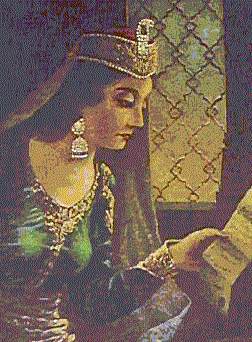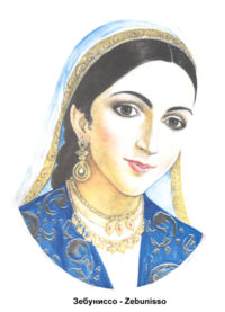
Being a favourite, she was exposed to the affairs of the Mughal court. With a sound education in the arts, languages, astronomy and sciences of the day, Zeb-un-Nissa turned into an aware and sensitive princess. She never married and kept herself occupied by poetry and a spiritual Sufi quest. This is the irony – Aurangzeb’s daughter was an antithesis of her father’s persona and politics. Zeb-un-Nissa was both a Sufi and a gifted poet. The Divan-i-Makhfi – a major divan – is credited to her name. Given her father’s dislike for poetry, she could only be makhfi – the invisible. There was subversion too – like all rebels she attended and participated in the literary and cultural events of her age, dressed in her veil.
Unlike her puritanical father, Zeb-un-Nissa did not share her father’s orthodox views on religion and society. Steeped in mystic thought, her ghazals sang of love, freedom and inner experience:
“Though I am Laila of Persian romance
my heart loves like ferocious Majnun
I want to go to the desert
but modesty is chains on my feet.
A nightingale came to the flower garden
because she was my pupil
I am an expert in things of love.
Even the moth is my disciple!”
(translated by Willis Barnstone)
Her verses, comprising 400 ghazals, and published as Divan-i-Makhfi would have bothered Aurangzeb. Her inclusive poetic vision ran against the puritanical state and society that Aurangzeb cherished.
I bow before the image of my Love
No Muslim I
But an idolater
I bow before the image of my Love
And worship her
No Brahman I
My sacred thread
I cast away, for round my neck I wear
Her plaited hair instead
(Divan-e-Makhfi)

This garden, in the pattern of Paradise, has been founded
The garden has been bestowed on Mian Bai
By the beauty of Zebinda Begam, the lady of the age
 According to Latif, Mian Bai was the favourite female attendant of Zeb-un-Nissa. Shah Jahan Nama also throws some light on the gardens and their gift to the lucky Bai. Since Mian Bai had supervised the laying out of these gardens, the local people called it Mian Bai’s gardens. Respecting local opinion, Zeb-un-Nissa bequeathed these gardens to her favourite slave girl. Eventually, she fell out of royal favour, not for her eclectic pursuits but for the rebellion of her brother Akbar, who proclaimed himself as emperor in 1681. While the rebellion was short and unsuccessful, Zeb-un-Nissa kept corresponding with her exiled brother; this landed her imprisonment in a Delhi fortress until her death in 1702. A recent book, Captive Princess: Zeb-un- Nissa, daughter of Emperor Aurangzeb, attempts to examine the causes of her imprisonment, her worldview and reconstructs her life. The work highlights the political differences that she developed with her father and shows how alien Aurangzeb’s style of governance was to her soul. She never accompanied him on his Deccan campaigns. Jadu Nath Sarkar states that Zeb-un-Nissa died in Delhi and was buried in the ‘Garden of Thirty Thousand Trees’ outside the Kabuli gate.
According to Latif, Mian Bai was the favourite female attendant of Zeb-un-Nissa. Shah Jahan Nama also throws some light on the gardens and their gift to the lucky Bai. Since Mian Bai had supervised the laying out of these gardens, the local people called it Mian Bai’s gardens. Respecting local opinion, Zeb-un-Nissa bequeathed these gardens to her favourite slave girl. Eventually, she fell out of royal favour, not for her eclectic pursuits but for the rebellion of her brother Akbar, who proclaimed himself as emperor in 1681. While the rebellion was short and unsuccessful, Zeb-un-Nissa kept corresponding with her exiled brother; this landed her imprisonment in a Delhi fortress until her death in 1702. A recent book, Captive Princess: Zeb-un- Nissa, daughter of Emperor Aurangzeb, attempts to examine the causes of her imprisonment, her worldview and reconstructs her life. The work highlights the political differences that she developed with her father and shows how alien Aurangzeb’s style of governance was to her soul. She never accompanied him on his Deccan campaigns. Jadu Nath Sarkar states that Zeb-un-Nissa died in Delhi and was buried in the ‘Garden of Thirty Thousand Trees’ outside the Kabuli gate.
It is said that when the railway line was laid at Delhi, her tomb was demolished, and the coffin and the inscribed tombstone were shifted to Akbar’s mausoleum at Sikandara Agra. According to SM Latif, a poet versified her chronogram in the following words:
A fountain of learning, virtue, beauty and elegance,
She was hidden as Joseph was in the well
I asked reason the year of her death.
The invisible voice exclaimed: “the moon became concealed”
Latif writes that the last phrase mahmakhfi-shud cannot be adequately translated. Literally it means the concealed moon, but makhfi was also the nom de plume of Zeb-un-Nissa and there is a meaningful wordplay here. However, much as we make conjectures about a full life lived, a good measure of the passions and poetry of the princess shall remain concealed and quite un-translatable.
NOTE: an earlier version of this post was published by the Friday Times



















































Salamalikum,
Who was Zebunnisa Hamidullah? And when was this street named?
She was Pakistan’s “first” female journalist and was quite famous. Also, a leading “feminist”—whatever that means. The street was named after her in the ’60s (see wiki link below). But, had it been named after Aurangzeb’s daughter, it would have been changed and right so (again, if what’s written is true) by Zia.
Read more about her: http://en.wikipedia.org/wiki/Zaib-un-Nissa_Hamidul lah
Raza Sahib: Please translate the persian couplet you mentioned. In any case, I regret using the word fahash not because I think things ascribed to her do not fall under fahashi (they clearly do and she is NOT a “sufi” by which if you mean religious/pious/zaahidah) but because the information cannot be substaniated (as you mentioned there are many rumors as well). Again, I’m going by what’s stated here.
Exchange between Zia & MQ & Ibrahim is very interesting and informative. The old Elephantine Street in Karachi is most likely named after Zeb-un-Nisa Hamidullah. Some how we Pakistanis are not very fond of Moguls even though their period is when most of our cultural ethos where established. Taimoor’s Empire extended all the way up to Lahore and what is Pakistan today was once part of his Central Asian Empire. So checkered is our history. But I just love the phrase ‘Mah-e-Makhfi Shud’. So poetic.
Akbar started the practice of marrying Rajput princesses for the political expedience but by the time Noor Jahan entered, the royal court was so heavily influenced by the locals that the practice had to be checked, if nothing else then at least for the political reasons. She made sure that Shah Jahan married her own niece, a girl of Persian origin. Early Moguls were Turkic but the royal household had heavy Persian influence. The court language eventually was changed from Turkish to Persian, a much more advanced and sophisticated language at the time.
Great comments again! No, Zia you are welcome to make further comments and lead a discussion – this is an open and democratic forum.
I am not sure about the Zebunnissa street but the digest was surely named after this Mughal name.
Mughals were of Turk-Mongol descent but in the subcontinent they localized themselves. Hamayun married a Persian Princess Hamida Bano and received Persian protection when Sher Shah Suri challenged him and drove him out of India. Later, Akbar married a Rajput princess who was also the mother of Mughal princes.
With the ascent of Noor Jehan (of Persian origin) there were two strong groups at the Mughal court – the Persian/Shiites and the Turks and there was much tussle for power betweent the two for titles and governor-ships.
This rambling was to set the context.
About Ibrahim Saheb’s view of the poor Sufi princess, I have nothing to say except quote a Persian verse:
fikr-e-har kas baqadre himmate oost..
Who was Zebunnisa Hamidullah? And when was this street named?
Salamalikum,
MQ: In your zeal to drag Ziaul Haq’s name through mud at every opportunity, try not to jump to conclusions. Zeb-un-Nisa Street in Karachi is named after Zeb-un-Nissa Hamidullah and NOT this fahash (if what’s written is true) daughter of Aurangzeb…not that Zeb-un-Nissa Hamidullah should be a great role model for Muslim women, but she’s definitely thousand times better than Aurangzeb’s daughter (again, if what’s written is true).